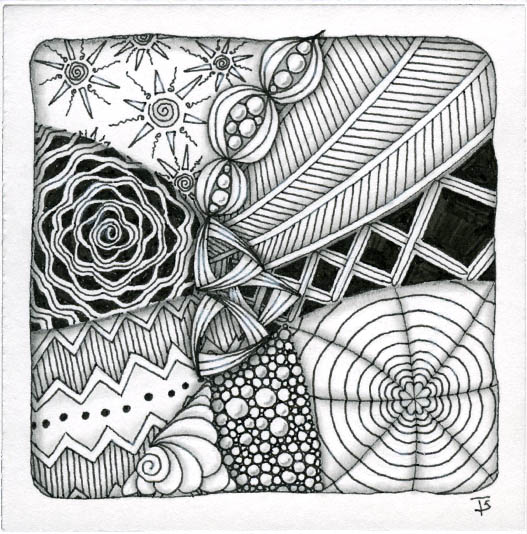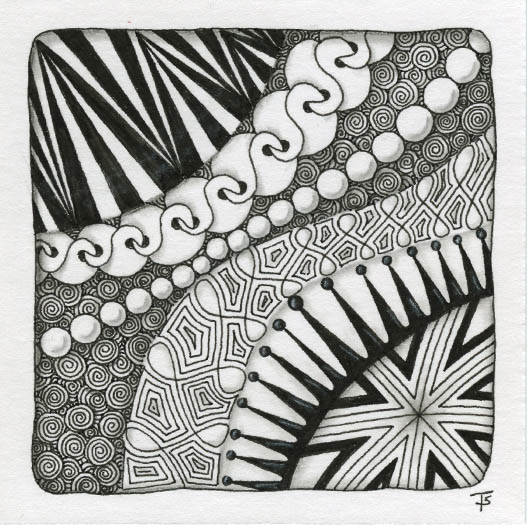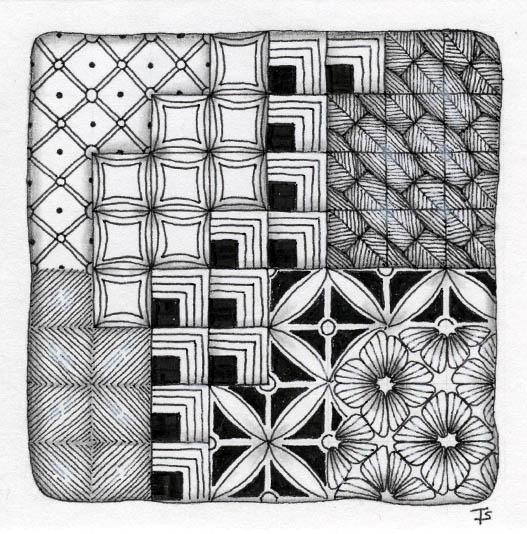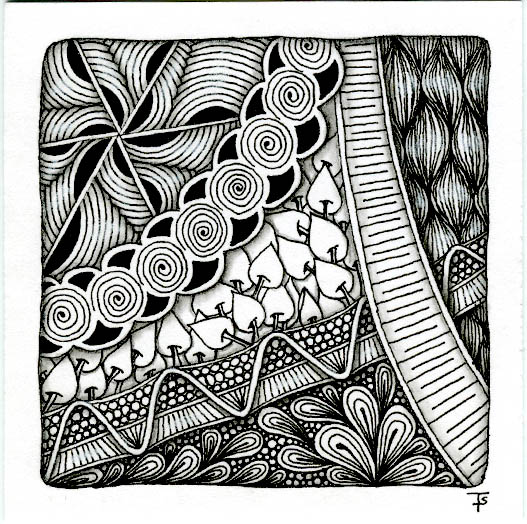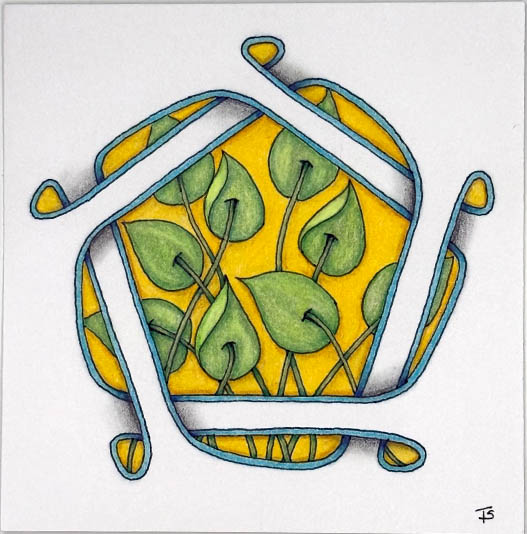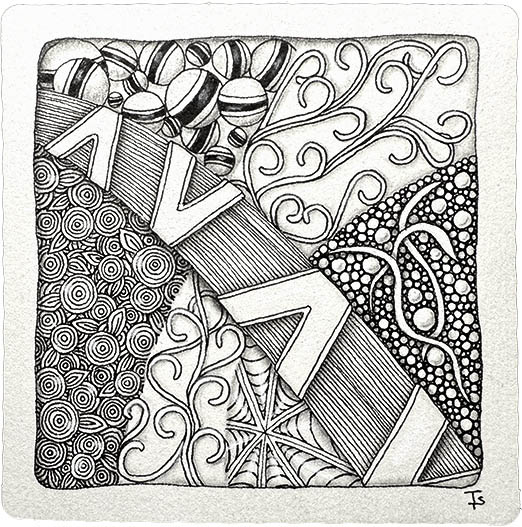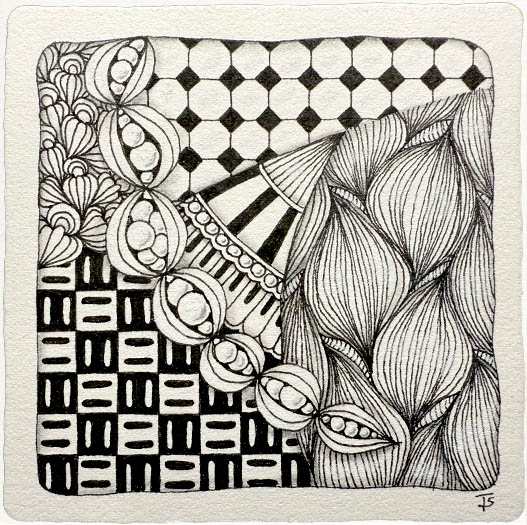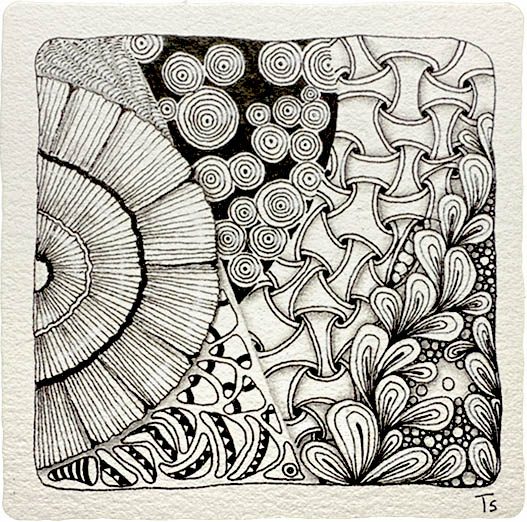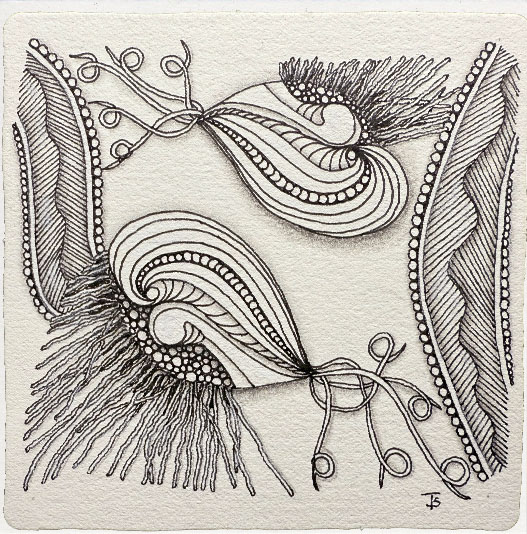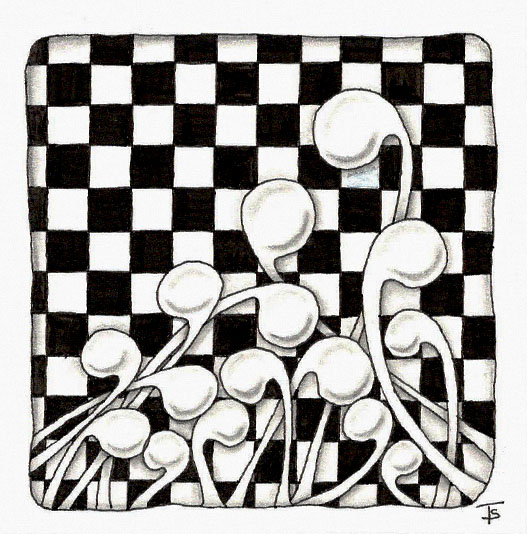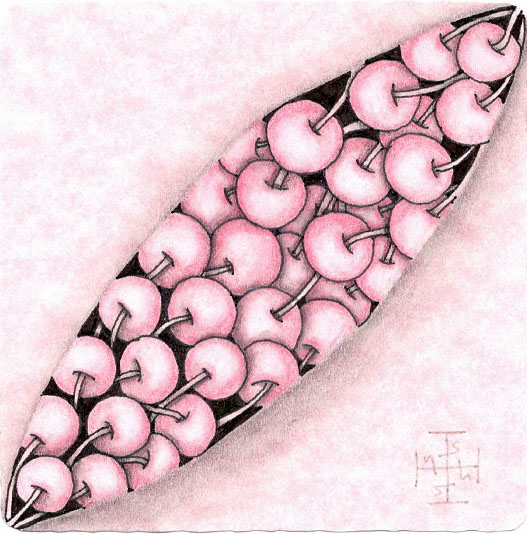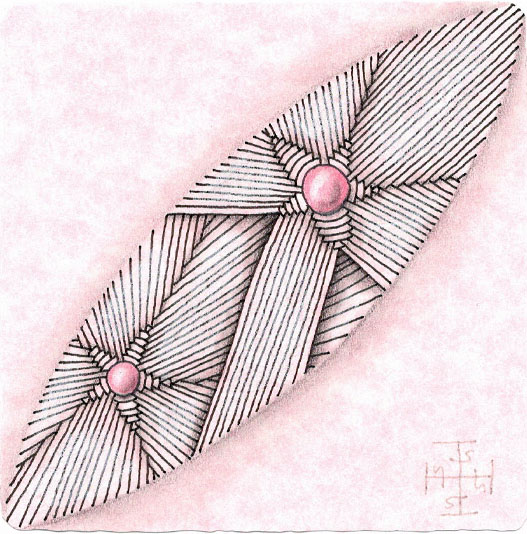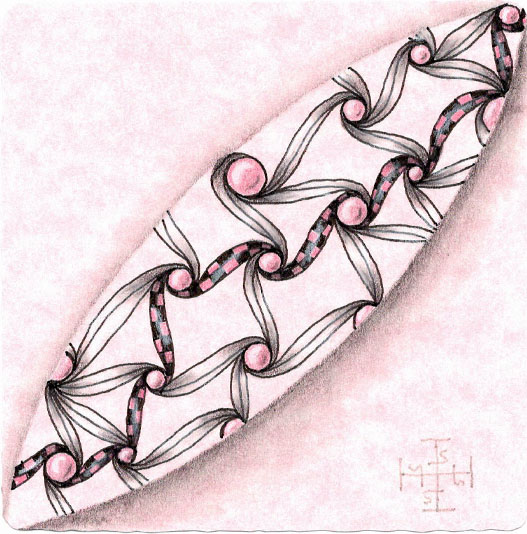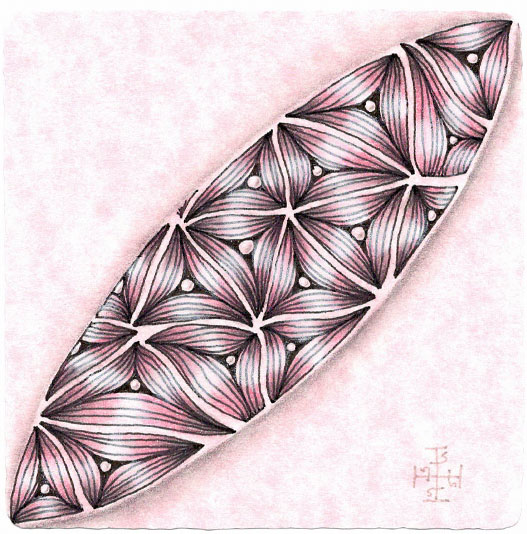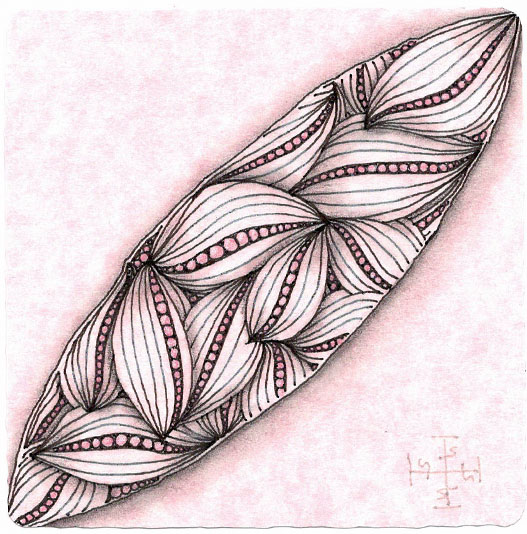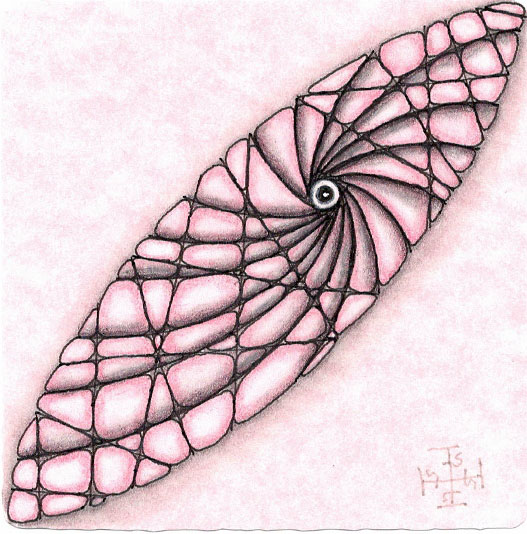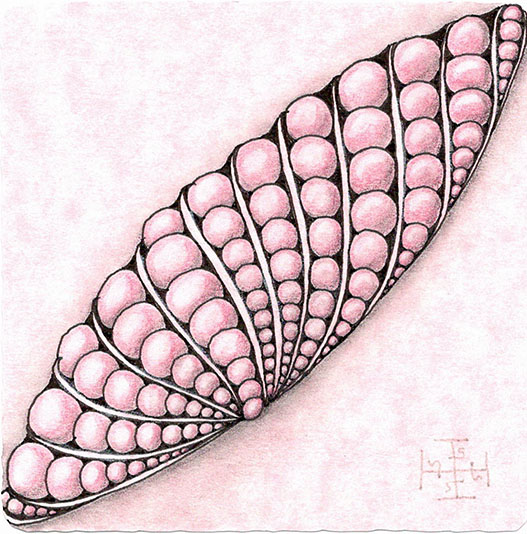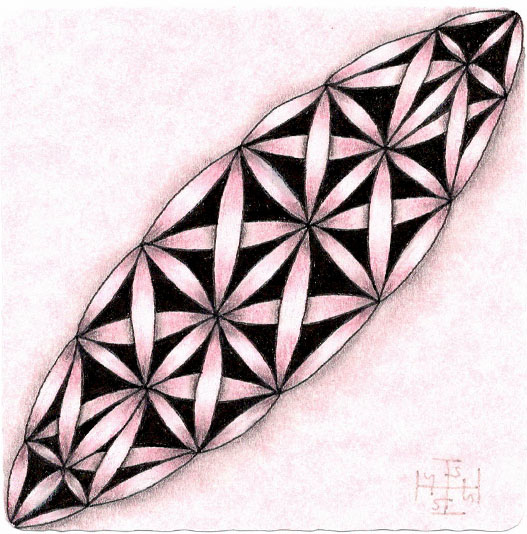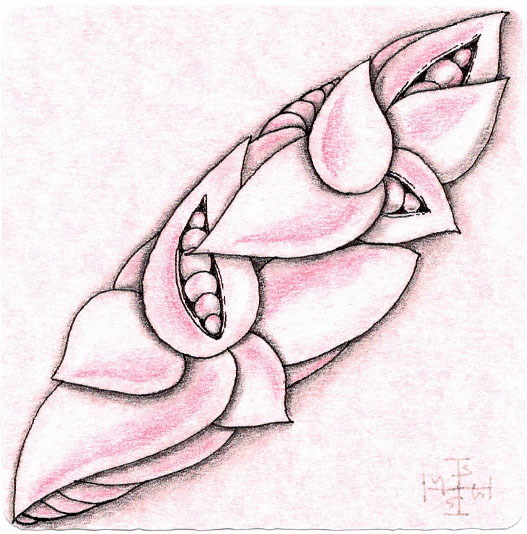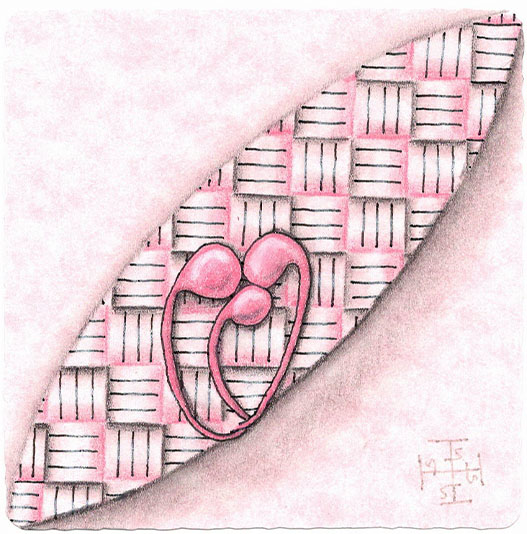Complex. There are days when our lives are full of complication. This tile reminds me that there is a way of organizing and taking things one step at a time that restores calm and confidence.
There are a lot of tangles here, with many not seeming to go together at all. But the Zentangle Method does an amazing job of making it all work, ending up with a tile that makes artistic sense.
A few, very bold tangles can make a huge statement, taking over the whole design. In this case, I tried to balance them out by placing them in opposite corners.
The Beedz tangle was originally shown with the orbs colored in with the pen, leaving only a bright highlight. I thought they would look better just left white in this composition.
Zentangle drawn on Strathmore Vellum Bristol using a black, Micron pen. Shading done with graphite pencil. Highlights created with white chalk pencil.
What would you do if you were selecting tangles randomly and they were all grid type?
Here, the “string” was a grid that covered the entire design area. Each tangle was applied within this grid, with any additional lines added to the grid as needed.
I like the way this came out, and I like the variations within the various tangles.
Fun!
Zentangle drawn on Strathmore Vellum Bristol using a black, Micron pen. Shading done with graphite pencil.
Several “ribbon” type tangles appeared in the random selection today. I used them to create the “string” and filled in the spaces between with more randomly selected tangles.
I think it worked out well!
Zentangle drawn on Strathmore Vellum Bristol using a black, Micron pen. Shading done with graphite pencil.
Tangles: Doo Dah Ixorus Olb Pais Pokeleaf Snail Twing
Ever since I saw the tangle Tissoooh, by Tomàs Padrós, I wanted to try using it as a frame for other tangles. Today, I got a chance to try it.
I kept it very simple, but I was very careful and deliberate with my lines, taking my time and thinking carefully before making each one.
After adding the Pokeleaf to the center, and having it peek through the “windows”, I used colored pencil to give all of it depth and dimension.
It looks like I need to practice the tangle “Hollis” more… This one kind of took off and created a life of it’s own!
Zentangle drawn on a standard, white Zentangle tile using a black, Micron pen. Shading done with graphite pencil. Highlights done with white chalk pencil.
Tangles: Claws Fracas Hollis Jetties Mysteria Pixoze
I used to be really nervous about trying anything based on an ogee grid, such as the African Artist tangle. I think I am finally over it. I have been practicingng drawing Narfello over and over and over, to the point where I am comfortable with it. So when African Artist came up, I was surprised at how easy it now feels!
Zentangle drawn on a standard, white Zentangle tile using a black, Micron pen. Shading done with graphite pencil. Highlights done with white chalk pencil.
Random tangles can play nice with each other!
For this tile I created a string and then filled it with randomly selected tangles.
This one worked well, and when I was done, I felt much closer to my normal tangling style. I had less hesitation, fewer crazy lines and the whole thing was very Zen, from start to finish.
Zentangle drawn on a standard, white Zentangle tile using a black, Micron pen. Shading done with graphite pencil. Highlights done with white chalk pencil
This started with a Zentangle tile that I found in my stash that had a string already drawn on it.
Then I started drawing tangles based on random numbers.
This system usually works really well for me… Usually.
The string had two large “loops” in it, and I thought they would work well to place the tangle Auragin. But it only filled part of the loops.
Adding 3d Mookas looked ok, but still left some room.
It’s a new month!
Yesterday, I didn’t tangle. Having finished the Bijou Be Well challenge, I took the day off.
Today, I wanted to do something simple and bold, since I was returning to my basic routine.
I love Mooka, and I often use this version as a bit of a representation of people… in this case, a large crowd. They look like they are having a party with lots of conversations going on to me.
This is the final day for Zentangle’ “Bijou Be Well” project, 2025 version, in honor of Mental Health Awareness Month. I began on May 10, and you can read that post here I’ve stuck with this project, tangling every day for 21 days! I did it when it was easy and fun. I did it when I wasn’t having a great day. I did it when I loved the tangle and the creation… and when I didn’t.
Today’s tile for Zentangle’s “Bijou Be Well 2025” project features the tangle Arukas.
The Bijouism for the day is “Dream”.
The video for this tangle is here .
Zentangle drawn on pink printed parchment card stock using a black, Micron pen. Coloring done with colored pencil. Shading done with black colored pencil and graphite pencil. Highlights done with white colored pencil.
#zentangle #tangle #BeWell2025 #MentalHealthAmerica #MentalHealthAwarenessMonth #4Rebecca
Tangles: Arukas
Today’s tile for Zentangle’s “Bijou Be Well 2025” project features the tangle Crazy Cadent.
The Bijouism for the day is “Find Balance”.
The video for this tangle is here .
Zentangle drawn on pink printed parchment card stock using a black, Micron pen. Coloring done with colored pencil. Shading done with black colored pencil and graphite pencil. Highlights done with white colored pencil.
#zentangle #tangle #BeWell2025 #MentalHealthAmerica #MentalHealthAwarenessMonth #4Rebecca
Tangles: Crazy Cadent
Today’s tile for Zentangle’s “Bijou Be Well 2025” project features the tangle Tripoli.
The Bijouism for the day is “Look up”.
The video for this tangle is here .
Zentangle drawn on pink printed parchment card stock using a black, Micron pen. Coloring done with colored pencil. Shading done with black colored pencil and graphite pencil. Highlights done with white colored pencil.
#zentangle #tangle #BeWell2025 #MentalHealthAmerica #MentalHealthAwarenessMonth #4Rebecca
Tangles: Tripoli
Today’s tile for Zentangle’s “Bijou Be Well 2025” project features the tangle Ravel.
The Bijouism for the day is “Stretch”.
The video for this tangle is here .
Zentangle drawn on pink printed parchment card stock using a black, Micron pen. Coloring done with colored pencil. Shading done with black colored pencil and graphite pencil. Highlights done with white colored pencil.
#zentangle #tangle #BeWell2025 #MentalHealthAmerica #MentalHealthAwarenessMonth #4Rebecca
Tangles: Ravel
Today’s tile for Zentangle’s “Bijou Be Well 2025” project features the tangle Nzepple.
The Bijouism for the day is “Change and Grow”.
The video for this tangle is here .
Zentangle drawn on pink printed parchment card stock using a black, Micron pen. Coloring done with colored pencil. Shading done with black colored pencil and graphite pencil. Highlights done with white colored pencil.
#zentangle #tangle #BeWell2025 #MentalHealthAmerica #MentalHealthAwarenessMonth #4Rebecca
Tangles: Nzepple
Today’s tile for Zentangle’s “Bijou Be Well 2025” project features the tangle Purk.
The Bijouism for the day is “Explore”.
The video for this tangle is here .
Zentangle drawn on pink printed parchment card stock using a black, Micron pen. Coloring done with colored pencil. Shading done with black colored pencil and graphite pencil. Highlights done with white colored pencil.
#zentangle #tangle #BeWell2025 #MentalHealthAmerica #MentalHealthAwarenessMonth #4Rebecca
Tangles: Purk
Today’s tile for Zentangle’s “Bijou Be Well 2025” project features the tangle Fife.
The Bijouism for the day is “Nurture”.
The video for this tangle is here .
Zentangle drawn on pink printed parchment card stock using a black, Micron pen. Coloring done with colored pencil. Shading done with black colored pencil and graphite pencil. Highlights done with white colored pencil.
#zentangle #tangle #BeWell2025 #MentalHealthAmerica #MentalHealthAwarenessMonth #4Rebecca
Tangles: Fife
Today’s tile for Zentangle’s “Bijou Be Well 2025” project features the tangle Idoz.
The Bijouism for the day is “Add love”.
The video for this tangle is here .
Zentangle drawn on pink printed parchment card stock using a black, Micron pen. Coloring done with colored pencil. Shading done with black colored pencil. Highlights done with white colored pencil.
#zentangle #tangle #BeWell2025 #MentalHealthAmerica #MentalHealthAwarenessMonth #4Rebecca
Tangles: Idoz
Today’s tile for Zentangle’s “Bijou Be Well 2025” project features the tangle Keeko.
I’ve also added Mooka, instead of the Pokeleaf shown in the video. I did this because today was 8th grade graduation for my teen! So I did a little “family portrait” to commerate the event.
The Bijouism for the day is “Be brave, be true”.
The video for this tangle is here .
Zentangle drawn on pink printed parchment card stock using a black, Micron pen. Coloring done with colored pencil. Shading done with graphite and colored pencil. Highlights done with white colored pencil.
